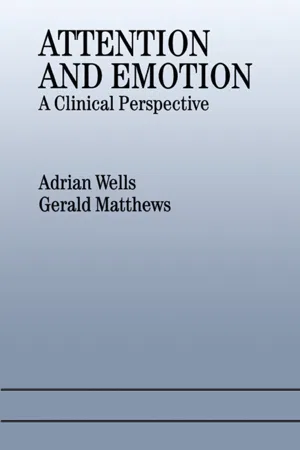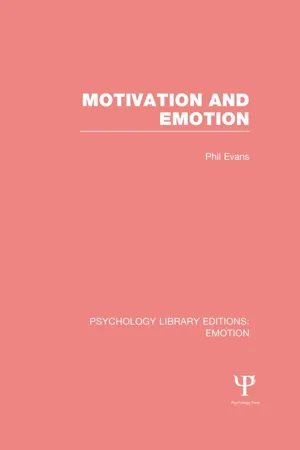Cognitive Theory of Emotion
The Cognitive Theory of Emotion suggests that our emotions are influenced by our thoughts, perceptions, and interpretations of events. It emphasizes the role of cognitive processes in shaping emotional experiences, proposing that our appraisal of a situation determines our emotional response. This theory highlights the significance of mental processes in understanding and managing emotions.
5 Key excerpts on "Cognitive Theory of Emotion"
- Chris R. Brewin(Author)
- 2013(Publication Date)
- Psychology Press(Publisher)
...Cognitive theories of emotion assume that a stimulus or a situation must first be attended to, recognized or classified, and related to previous experiences stored in memory before it can be evaluated or can arouse an emotional response. A small number of “basic” emotional responses have been identified, and it has been suggested that other emotions are made up of a blend of these. The five most commonly cited are happiness, anger, fear, sadness, and disgust, although, using the criterion that the facial expression associated with a basic emotion should be recognized all over the world, Ekman (1973) has argued that surprise should be included. Three influential proponents of cognitive theories of emotion are Schachter (1964), Lazarus (1966), and Weiner (1986). Schachter's Theory This two-factor theory of emotion has been extremely influential. According to Schachter, the experience of emotion is dependent on the conjunction of two elements, the perception of peripheral physiological arousal and the label that such arousal is given. The experience of physiological arousal, such as churning of the stomach or rapid beating of the heart, is considered to be relatively nonspecific, i.e., it does not take distinct forms corresponding to different emotional states. Emotional specificity is provided by cognitive appraisal of the source of the arousal. In most instances arousal will be attributed automatically to the stimulus or situation that elicits it, probably on the basis of the temporal contiguity of stimulus and reaction (see Chapter 6 for a discussion of attributional determinants)...
- eBook - ePub
Attention and Emotion
A Clinical Perspective
- Gerald Matthews, Adrian Wells(Authors)
- 2016(Publication Date)
- Psychology Press(Publisher)
...CHAPTER ONE Introduction: Cognitive Theory of Emotional Disorders Clinical psychology has been revolutionised by an influx of ideas and techniques derived from cognitive psychology and by the central metaphor that the mind functions as a processor of information. The basic assumption of the clinical application of cognitive theory has been expressed most economically by Ellis (1962). He suggests that emotional disorder is associated with irrational beliefs, particularly about the self. Irrational beliefs lead to both unpleasant emotions and ineffective, maladaptive behaviour. This theory expresses several hypotheses which have become widely accepted by clinicians working within the cognitive approach. First, beliefs have a causal effect on emotion and well-being. This hypothesis differentiates the cognitive approach from behaviourism. Second, beliefs, as causal agents, are expressed in verbal, propositional form, and can be accessed consciously during therapy. This hypothesis distinguishes the cognitive approach from most psychodynamic approaches, in which “latent” beliefs are unconscious. Third, therapy should be directed towards changing beliefs through restructuring cognitions, as in Ellis’ (1962) rational emotive therapy, in which the patient is taught to recognise and modify irrational, harmful self-beliefs. The core assumptions of the cognitive approach just described are not in themselves sufficient to provide a workable model of emotional disorder. The most obvious difficulty is the resistance to change in irrational beliefs often encountered clinically. The person’s self-knowledge is not simply an internal “file” of disconnected beliefs which the therapist can erase and replace with more realistic propositions. People seem to construct and revise self-beliefs actively on the basis of some internal set of ground rules for interpreting the world...
- Willis Overton, Ulrich Mueller, Judith Newman(Authors)
- 2007(Publication Date)
- Psychology Press(Publisher)
...3 THE FEELING BODY: TOWARD AN ENACTIVE APPROACH TO EMOTION Giovanna Colombetti University of Exeter Evan Thompson University of Toronto For many years, emotion theory has been characterized by a dichotomy between the head and the body. In the golden years of cognitivism, during the 1960s and ’70s, emotion theory focused on the cognitive antecedents of emotion, the so-called “appraisal processes.” Some saw bodily events largely as by-products of cognition, and as too unspecific to contribute to the variety of emotion experience. Cognition was conceptualized as an abstract, intellectual, “heady” process separate from bodily events. Although current emotion theory has moved beyond this disembodied stance by conceiving of emotions as involving both cognitive processes (e.g., perception, attention, and evaluation) and bodily events (e.g., arousal, behavior, and facial expressions), the legacy of cognitivism persists in the tendency to treat cognitive and bodily events as separate constituents of emotion. Thus, the cognitive aspects of emotion are supposedly distinct and separate from the bodily ones. This separation indicates that cognitivism’s disembodied conception of cognition continues to shape the way emotion theorists conceptualize emotion. During the last two decades, this disembodied conception of cognition has been seriously challenged by the rise of embodied and situated approaches in cognitive science (see Clark, 1997; Varela, Thompson, & Rosch, 1991). The dynamical systems approach has challenged the idea that cognition is the manipulation of abstract representations according to syntactic rules, and has proposed instead that cognition emerges from the coupled interactions of the brain, body, and environment (Beer, 2003; Kelso, 1995; Port & van Gelder, 1995; Thelen & Smith, 1994; Thelen, Schöner, Scheier, & Smith, 2001)...
- eBook - ePub
- Paula M. Niedenthal, François Ric(Authors)
- 2017(Publication Date)
- Psychology Press(Publisher)
...But are emotion and cognition really two distinct processes? Maybe emotions are a type of cognition. Or maybe emotions do not come about without cognition. In either case, how can we say that emotions influence cognition? The question of whether emotion is distinct from cognition is one that has been debated in philosophy for centuries and more recently in psychology. For some theorists, emotion and cognition refer to two independent systems in the brain (Descartes, 1644; Zajonc, 1980, 1984). According to this view, emotions can occur prior to cognition, are independent of cognitive processes, and can influence their course (Zajonc, 1980). For others, cognition precedes emotion and is a necessary condition for the occurrence of emotion (Lazarus, 1982). Specifically, in this second view, emotions arise from cognitive appraisals of a situation (see Chapter 1). If emotion is dependent upon cognition, then the assertion that emotions can influence cognition is actually less meaningful. It would mean that emotions influence cognition, and that is not a very interesting hypothesis. The issue of how to define emotion and cognition is unresolved. We can’t answer whether emotion and cognition are independent and, if so, which one occurs first. Probably it is accurate to say that emotion and cognition are, at the very least, interdependent (Storbeck & Clore, 2007). Cognitive processes may alter emotion (for example, cognitive reappraisal can affect which emotion is experienced), and emotion can influence, or regulate, cognitive processes in the many ways we describe in the present chapter. We start by introducing models of how emotions are represented in our cognitive system. In particular, we briefly describe and compare two general classes of models of how emotion knowledge is stored and structured in our cognitive system: the associative network models of emotion and the embodied simulation models...
- eBook - ePub
- Phil Evans(Author)
- 2014(Publication Date)
- Psychology Press(Publisher)
...10 Affect, emotion, and cognition We left emotion at the end of chapter 6 in a state of ‘becoming’. Simple physiological theories such as those of James and Lange were shown to be inadequate. The famous experiment by Schachter and Singer (1962) turned out to be more noteworthy for the push it gave to increasingly cognitive ways of looking at emotion than for the definitiveness of its findings. In this chapter we examine further the more recent ‘cognitivization’ of emotion; we shall see that arguments about the role of cognition in emotion reflect conceptual confusion as much as genuine differences of opinion. If indeed linguistic philosophers wished to identify the one area of psychology which they would find most tiresome it would probably be the area of emotion. For reasons that will become apparent as this chapter develops, I have chosen to include the additional word ‘affect’ to share pride of place in the chapter heading. Schachter’s hypothesis was that arousal and cognitions (drawn from the social context) are both necessary components of an emotion. The arousal, as it were, gives guts to the emotion. The cognition tells us what exactly the guts are being given to. I deliberately use this ‘hot’ language description so that we can contrast this position with the next bit of cognitivization that took place. In a series of experiments, Valins introduced a methodology based on giving false feedback of heart rate to subjects. In doing so, Valins was making a cognitive take-over bid for the entire emotion construct by suggesting that a person does not actually need veridical knowledge of gut arousal, through, for example, heart rate. Instead the person ‘coldly’ assesses information about external social context and internal bodily arousal...




